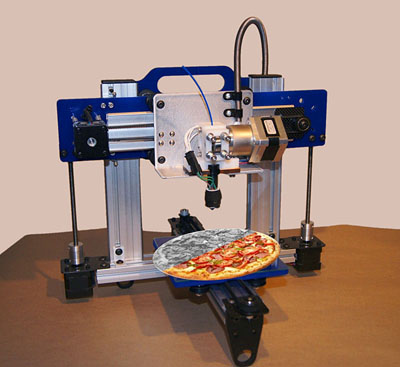Hungry? Print a Pizza
You’re just dying for a pizza: gooey cheese, sweet tomato sauce, blistered crust.
One problem: You’re millions of miles away from a pizza place, flying in some sort of spaceship toward Mars. Domino’s definitely doesn’t deliver up here, pal, so how do you satisfy your pizza craving?

Print one out.
Working with researchers from the Systems and Materials Research Corporation (SMRC), a materials and technology development company based in Texas, NC State researchers are figuring out the best ways to use a 3-D printer for printing pizza in outer space. NASA, you see, wants to provide space travelers some good old-fashioned comfort food, and gave SMRC a grant to figure out the mechanics behind pizza-making in space. SMRC, in turn, wants food-science expertise from NC State to figure out how to get the ingredients from the printer into an edible combination that looks and tastes like pizza.
Chris Daubert, professor and head of food, bioprocessing and nutrition sciences at NC State, says that pizza makes a good 3-D printing candidate because it is a layered product. So, theoretically, you could use a 3-D food printer to spray some dough onto a glorified hot plate, spray some sauce on top of the warming dough, and then spray some cheese to create – voila – pizza in space.
But wait a minute, Papa John. Think about the challenges of getting something as springy as pizza dough to come out of a nozzle that normally shoots out ink. Add to that the challenge of properly heating the items – The Abstract loves cold pizza, but with the caveat the pizza was hot at some time in its life. And don’t forget about that whole zero-gravity thing – also known as cooking while floating.
Daubert and researchers in his lab work specifically on the flow of food materials, or food rheology. So it’s their job to figure out how to make pizza dough with the proper consistency to flow into and through the 3-D printer, and then out of the 3-D printer via its nozzles, and then to repeat the process with the rest of the ingredients – sauce, cheese and, perhaps, other toppings.
Using common food-science testing equipment that lets food flow through it, the NC State researchers are testing current store-bought pizza doughs to see how they flow out of the device through different-sized nozzles. In other words, which dough consistency can be combined with the proper nozzle size to produce the proper layer of pizza crust? How do those factors change when the sauce layer is added? And how do they change again when you add the cheese to the pizza?
“Flexibility is the key when cooking in zero gravity,” Daubert says. “Getting food to flow out of a 3-D printer and making it appealing to an astronaut is a big challenge.”
- Categories:


